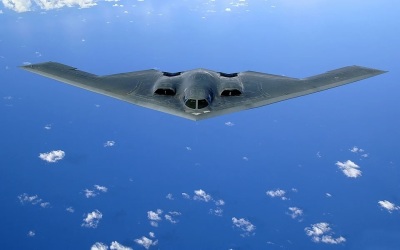
Less than 48 hours after American bombers struck the Iranian regime’s underground nuclear weapons facilities, President Donald Trump announced a ceasefire between Israel and Iran — and, despite a rocky start, Trump personally intervened to make it stick. The dramatic display provides a vivid vindication of Trump’s foreign policy strategy of achieving “peace through strength.”
The eventful hours began with America’s Saturday night bombing run, dubbed “Operation Midnight Hammer.” In a Sunday press conference, Defense Secretary Pete Hegseth and Joint Chiefs of Staff Chairman Air Force General Dan Caine described how the military kept Iran distracted by feints while undetected bombers flew from the United States, devastating Iran’s nuclear bunkers with the first-ever battlefield use of the 30,000-pound GBU-57 Massive Ordnance Penetrator (MOP) bomb.
The previous day, seven B-2 stealth bombers launched from Whiteman Air Force Base in Missouri. They flew for 18 hours, nearly halfway around the globe, maintaining only the minimal communication necessary to coordinate multiple mid-air re-fuelings. A “support package” of “fourth and fifth generation aircraft” escorted the bombers into enemy airspace “at high altitude and high speed, sweeping in front … for enemy fighters and surface-to-air missile threats,” Caine communicated.
Not only did the stealth bombers drop their payload with pinpoint accuracy from high altitude at high speed, but they also successfully entered and exited Iranian airspace without any apparent detection. “We are unaware of any shots fired at the package on the way out,” said Caine. “Iran’s fighters did not fly, and it appears that Iran’s surface-to-air missile systems did not see us. Throughout the mission, we maintained the element of surprise.” Certainly, it helped that Israel had already bombed Iran’s radar and air defense systems for 10 days prior.
In perfect coordination with this airstrike, a U.S. submarine launched more than two dozen Tomahawk missiles that destroyed key infrastructure sites at Isfahan, one of the targeted sites.
The elaborate mission also involved worldwide misdirection. At the same time that B-2 bombers were flying direct from Missouri to Iran, other B-2s flew west across the Pacific Ocean, from the same Missouri air base to Guam. The U.S. had made a show of moving another six B-2 bombers to Diego Garcia, an airbase in the Indian Ocean, which is close enough to Iran for bombers to hit Iranian targets and return without refueling. But these other bomber movements only served to misdirect Iran’s attention away from the real attack.
But the mission was not only for show. “Initial battle damage assessments indicate that all three sites sustained extremely severe damage and destruction,” Caine concluded. “We devastated the Iranian nuclear program,” Hegseth added.
The bombing mission bore additional fruit two days later when Trump convinced Israel and Iran to agree to a ceasefire. Israel agreed because the U.S. strike helped them achieve their objective of crippling Iran’s nuclear weapons program. Iran agreed because the U.S. strike convinced them they stood no chance of winning — perhaps not even of surviving — prolonged combat.
In other words, a U.S. demonstration of strength was immediately followed by peace, and it’s easy to draw causal links between the two.
And what an impressive demonstration of strength it was. “No other military in the world could have done this,” Caine insisted, adding that the mission demonstrated the “unmatched reach, coordination and capability of the United States military.”
America’s adversaries would likely just have to admit as much. Just look at Russia, which, after three years, has failed even to establish control of the skies above its smaller, weaker neighbor, Ukraine. In fact, Ukraine is the party in that conflict — pulling off surprising, decisive military strokes. Even China, perhaps America’s closest rival to achieving military parity, would have difficulty pulling off such a stunning surprise attack over such a long distance — against Australia, for instance.
Trump’s approach to Iran certainly had its critics — from both his partisan opponents and his own base. But the brilliant military success, followed up by an important diplomatic achievement, will go down in history as one of the high points of his second term in office.
“Trump deserves credit for ignoring the voices in Washington who counsel inaction out of an understandable but often paralyzing fear of unintended consequences,” wrote the National Review editors. “Every president in this century has promised to prevent Iran from achieving the capacity to break out with a nuclear weapon. Trump followed through on that talk … Both Israel and the U.S. will have emerged from this war with more credibility regarding preemption against nuclear proliferators — a condition that, one hopes, will put the fear of God into rogue states thinking about pursuing their own bomb.”
President Trump’s vision to “Make America Great Again” has many facets of varying importance, wisdom, and likelihood. Among the chief facets is reasserting America’s role as a powerful, peaceable force for good in international affairs. Foreign adversaries will fear to attack — or even antagonize — America if they understand America’s willingness to fight and best them on their own turf.
By authorizing the daring Operation Midnight Hammer, Trump defied the domestic doubters and succeeded. After four years of international apology and retreat, Trump has restored America’s classic foreign policy of ensuring peace through strength.
Originally published at The Washington Stand.
Joshua Arnold is a senior writer at The Washington Stand, contributing both news and commentary from a biblical worldview.
















